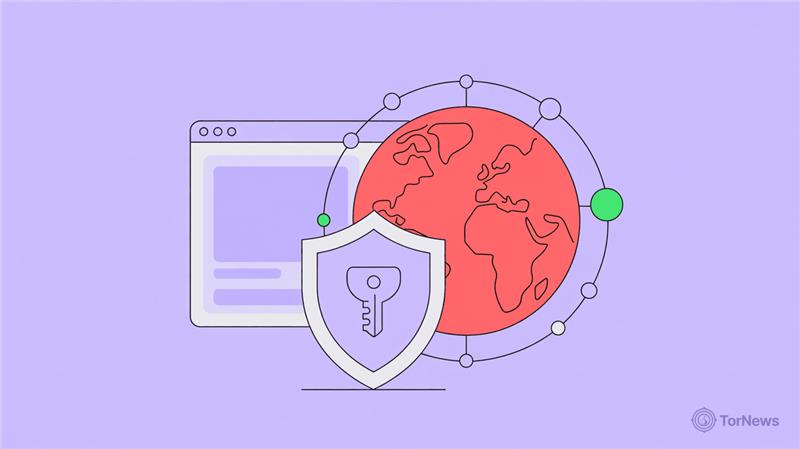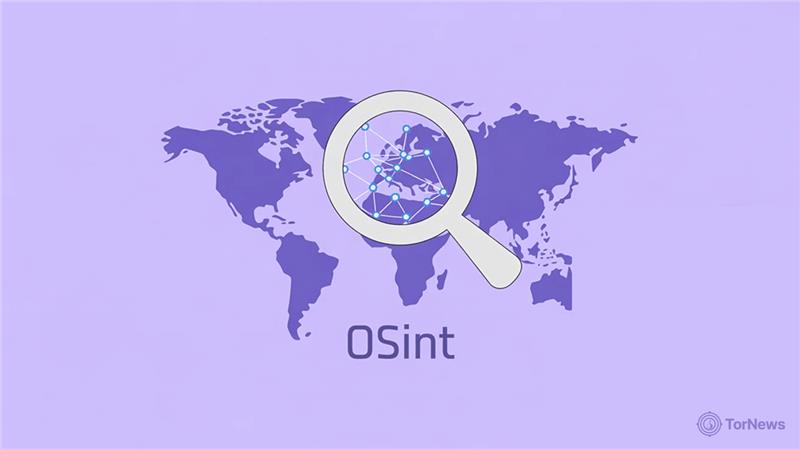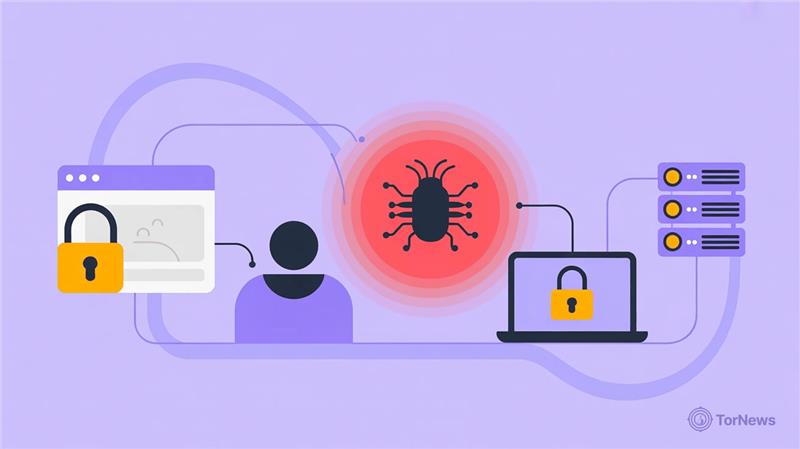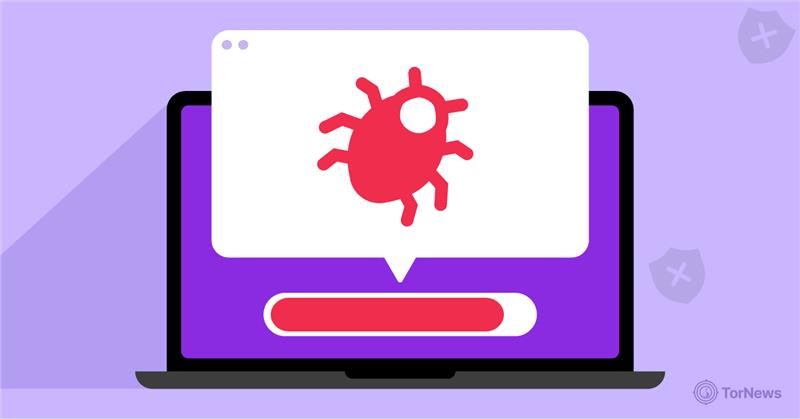In today’s hyper-connected world, social media isn’t just a place for memes and conversations. A goldmine of insights and a battleground for digital security. Monitoring social media has evolved into a powerful tool for awareness, strategy, and protection, from tracking customer sentiment to monitoring online threats.
In 2025, artificial intelligence, real-time analytics, and cybersecurity integration will transform how businesses, individuals, and security experts keep up with the ever-changing social landscape.
How Social Media Monitoring Works?
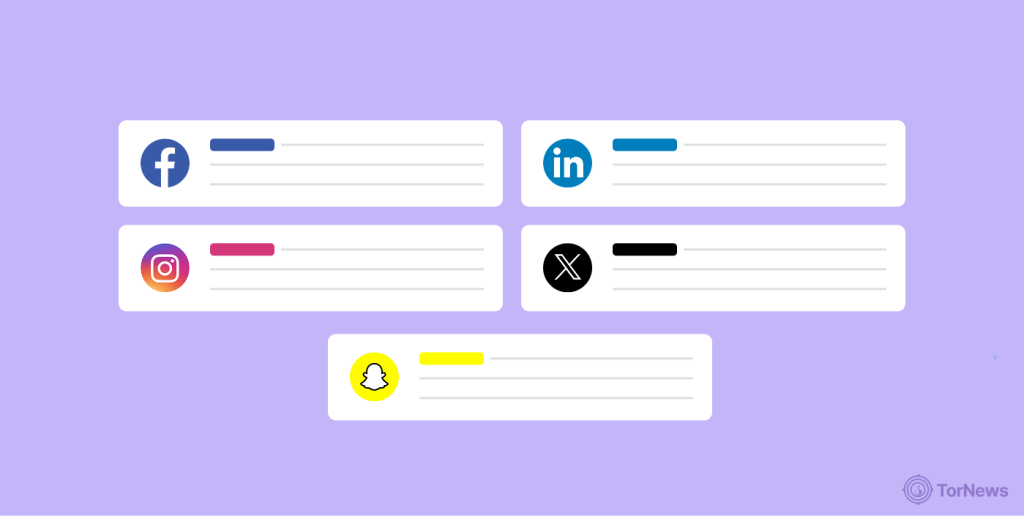
Understanding the way social media monitoring takes place helps you to decide the best ways to select tools & strategies to follow. Modern monitoring systems actually use top-notch technologies when gathering, processing, and analyzing large data from social media.
Let’s talk about all these separately below:
Data Collection and Aggregation
Social media monitoring begins with massive collection of data across many different platforms and sources. Advanced systems use application programming interfaces (APIs) from social platforms, web scraping technologies for sources without APIs, and specialized connectors for emerging platforms.
These data collection systems must take care of different content types including text posts, images, videos, comments, reviews, and multimedia content. Modern systems can handle millions of posts every one hour while still making sure that data quality remains relevant to the monitoring objectives.
Available aggregation systems gather these data from different sources into almost the same formats, and the aim is to make sure they perform the same analysis across different platforms and content types. This standardization is very important to achieve accurate cross-platform insights and comprehensive monitoring coverage.
Keyword and Hashtag Tracking
Sophisticated query systems that are not just simple keyword matching are very necessary to achieve effective monitoring. Modern systems achieve these goals by processing regular expressions, natural language and Boolean logic, to pick out contents that are more important while discarding the ones that don’t make sense, especially irrelevant mentions.
When it comes to advanced tracking systems, you can be sure that they easily pick the differences in spelling, slang terms, abbreviations, and contextual uses of keywords that a matching system won’t even notice.
When it comes to advanced tracking systems, you can be sure that they easily pick the differences in spelling, slang terms, abbreviations, and contextual uses of keywords that a matching system won’t even notice.
Sentiment Analysis and Natural Language Processing
Modern sentiment analysis makes use of ML (machine learning) algorithms that passed through comprehensive training using large datasets. These algorithms have been so trained that they can understand differences in languages, culture and even emotions that play out in diverse contexts.
These systems have the capacity to identify negative sentiment, positive ones and can even tell when emotions are intense, and appropriate for a situation or a context. Natural language processing abilities of these systems stems from intense analysis, entity recognition, & topic modeling.
These technologies help systems understand what people are talking, their reasons for such discussions and what they might do afterwards. Advanced systems can also identify sarcasm, irony, and other difficult linguistic structures that determine how people interpret sentiments. This sophistication helps brands to measure its perception and analyze customer satisfaction.
Real-time Alert Systems and Notifications
Sophisticated alert systems take the importance of notifications seriously and categorize them based on sentiment scores, the number of people reached and how important the source is relative to the goal and custom business rules.
By paying attention to these notifications, your team will receive alerts of important issues on time and wouldn’t waste their time on mentions that don’t matter. Advanced alerting covers everything that has to do with escalation protocols, giving assignments to the team and operating with communication systems that are available such as Slack, email, & SMS.
These features make sure that the alerts get to the right people through the communication channel they work with. Alert systems also allow you to adjust the levels of sensitivity to every alert depending on what you need and the response capabilities you already have in place.
Data Analytics and Insight Generation
Modern monitoring platforms can change raw data from social media platforms through advanced analytics into business information that you can work with to achieve set goals. Some of the tools that work for these systems include statistical analysis, data visualization and ML ( machine learning) which they use to identify patterns, trends, and even good opportunities that actually matter.
Talking about capabilities of analyzing data, you can expect analysis on trends, comparisons, grouping of demographics, & coming up with predictive modeling. With all these, you can easily understand the things that are happening, why it is so and what you can expect next.
Is Social Media Monitoring Different from Social Listening?
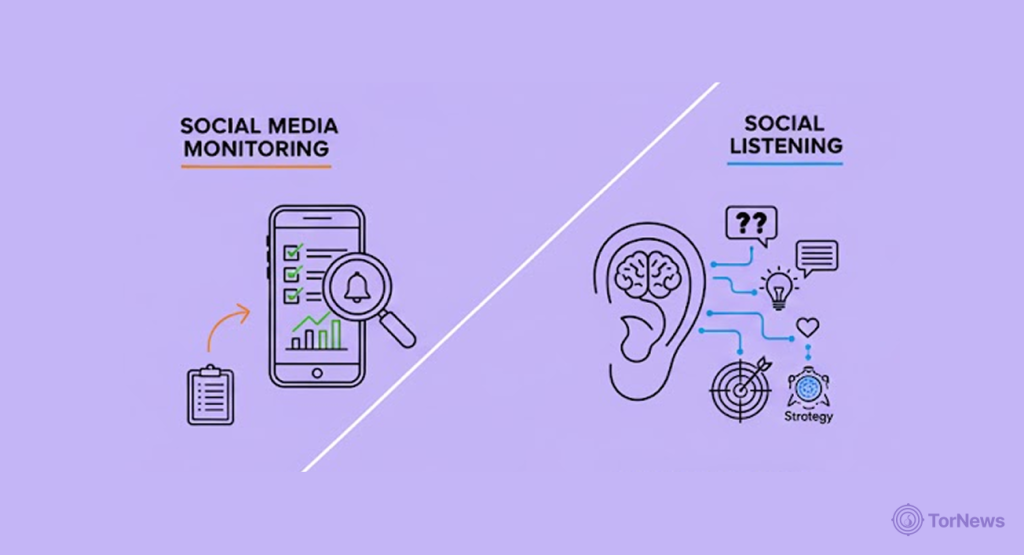
Social Media Monitoring
This one is like being a customer service rep; reactive, tactical, responsive, and engaging. In other words, you’re tracking conversations in line with your brand, products, or services. So, you interact with your audience in real-time:
- Reactive response system: You react immediately to comments, messages, complaints, or mentions as they pop up across platforms. Here, speed and direct engagement matters more than long-term strategic planning.
- Quantitative data focus: You measure follower counts, engagement rates, share volumes, mention frequencies, and reach statistics. That’s how you know whether there’s growth or not.
- Platform-specific tracking: You evaluate on platform at a time, transitioning from Facebook, to LinkedIn. Again, start from the platform your brand is already thriving in.
- Immediate question answering: You get quick insights into current brand perception and immediate customer needs.
What About Social Listening?
Here, you’re being a strategic consultant. You look into the broader digital conversation ecosystem with a proactive approach. As such, you analyze industry trends, customer motivations, and emerging opportunities or threats.
- Proactive strategic insights: You fish out emerging issues, trends, and opportunities early. Call it strategic positioning and prevention.
- Qualitative context analysis: Your audience’s emotions, motives, and contexts in every conversation become clearer. You begin to understand the “why” behind the “what.”
- All-inclusive digital coverage: You stretch beyond traditional social platforms to include blogs, forums, news sites, review platforms, podcasts, and other digital spaces. These are where relevant conversations happen.
- Strategic question resolution: You understand why people talk about certain topics, and what it means for your business. It helps curate long-term strategy and smart decision-making.
Social media monitoring and social listening can do well individually. However, the best results come when you infuse the efficiency of both practices.
Why is Social Media Monitoring Important?
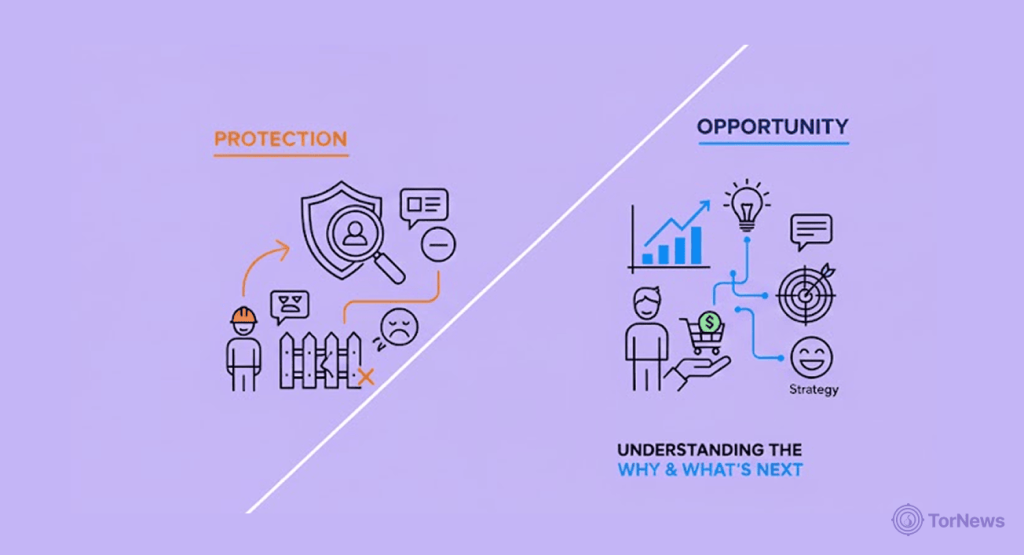
The answer is simple, gaining insight and devising actionable steps to follow up.
Remember that the practice helps you learn about your audience, how your business is performing, and lots more. Those are insights.
So what happens with such knowledge? If your metrics are low, you want to improve, find what works, and change the record. But for those whose performance is booming, you will focus on sustaining the upward trajectory.
Social media monitoring isn’t just some fancy tech hubby. Its importance covers multiple dimensions of business operations, cybersecurity, and strategic planning. So, understanding why it matters goes a long way.
Brand Reputation Management
In our world today, it can take roughly 24 hours to destroy the 30+ years reputation of a brand. Imagine 50+ negative customer reviews plus 1-star ratings on Starbucks. Even you will hesitate to do business with them. That’s the beginning of their downfall.
Now what social media monitoring does is to markup those events that can trigger negativity around a brand. The entities in charge then devise protective measures from resolving the issues to enhancing the brand’s image online.
In other words, the practice connects you to unsatisfied consumers, gives you a clue to their expectations, and suggests mediums of meeting their prerequisites. It’s a proactive ‘modus operandi’ that overwrites negativity in customer relationships.
Crisis Control and Prevention
Social media monitoring fosters early discovery, control, and prevention of online crises. It helps identify harmful topics and discussions early. For instance, on the X platform, you can see trending topics driving the closure of crypto related activities.
As such, you can find negative hashtags like #endcrypto, #bancrypto, and so on. If your business uses crypto for transactions, this potential uproar could affect you, right? So by monitoring your networks, you notice these early and change your medium of transactions to bypass any potential issues.
This is just an analogy to paint the picture. Moreover, with state-of-the-art systems, one can detect unusual surges in negative sentiment. You can point out influencers spreading sensitive content, and get insights on the next immediate attention.
Refined Customer Understanding and Engagement
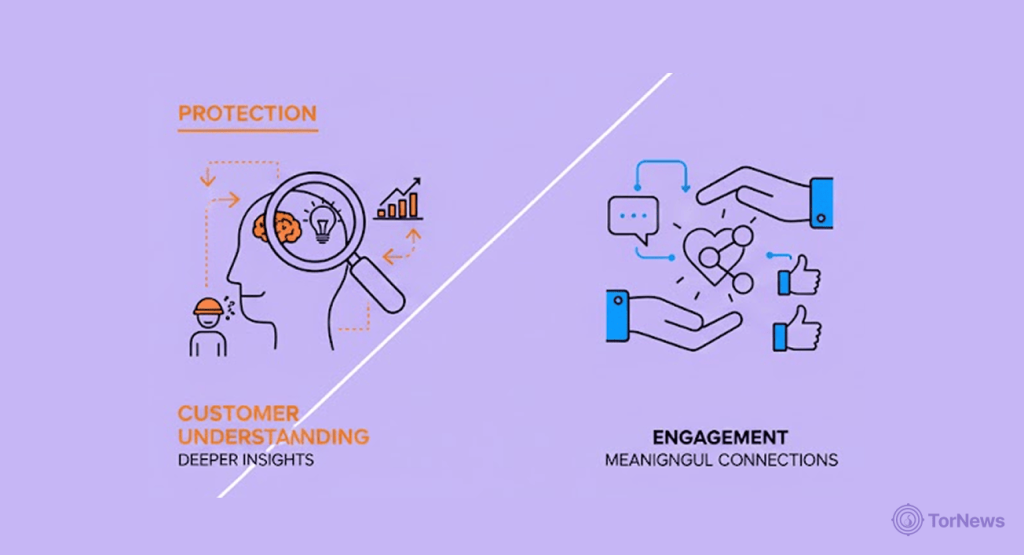
Keeping an eye on social networks usher unprecedented access to real-time customer sentiment and feedback. It isn’t shallow like the traditional market research because you’re capturing unfiltered customer experiences and opinions.
See it like a bridge between customers’ minds and brands. That’s how a brand can improve their services and products with realistic user experiences. It’s also how they identify widespread challenges of customers and opportunities for innovation.
Cyber Protection
The bad guys are on social media everyday, that’s how they pull off nefarious attacks on victims. But monitoring the socials reduces their chances. It helps identify phishing approaches, deceitful campaigns, impersonations, and other malicious activities.
Possibly, but AI-powered monitoring systems make it easier and faster. It detects suspicious patterns, markup orchestrated fakeries, and ping the security teams to take actions against potential threats early.
Competitive Edge
You know how a giraffe can see over the shoulders of even the King of the Jungle, social media monitoring gives you a long-neck view of what your competitors are doing. What activities, strategies, are in place, and how are customers opting for them? Social network monitoring answers these questions with practical steps at your fingertips.
Brands can track the campaigns of their competitors, assess their customer reviews, pinpoint opportunities, and refine them for their ventures. The best part, you don’t repeat the mistakes of the competitors. What’s more? You gain access to untapped market areas and even customer needs.
Good Legal Standing
A business that gets customers sharing their data online operates on mandatory regulations. The content you show and how you interact with these customers must follow a regulatory checklist.
- Don’t store user data or resell data for marketing purposes
- Do not provide misleading content
- Avoid copyright infringements
- And so on
Have I gone against any copyright rule unintentionally? Is my content misleading? Monitoring answers these questions. In situations where the brand is already facing the violation penalties, monitoring helps learn the best ways to avoid future repercussions.
This practice is so important for organizations in the healthcare, finance, or government sector. Because, entering the legal bad books attracts costly penalties that nobody wants to deal with. Brand termination? That’s just one of them!
Composition of Social Media Monitoring Tools
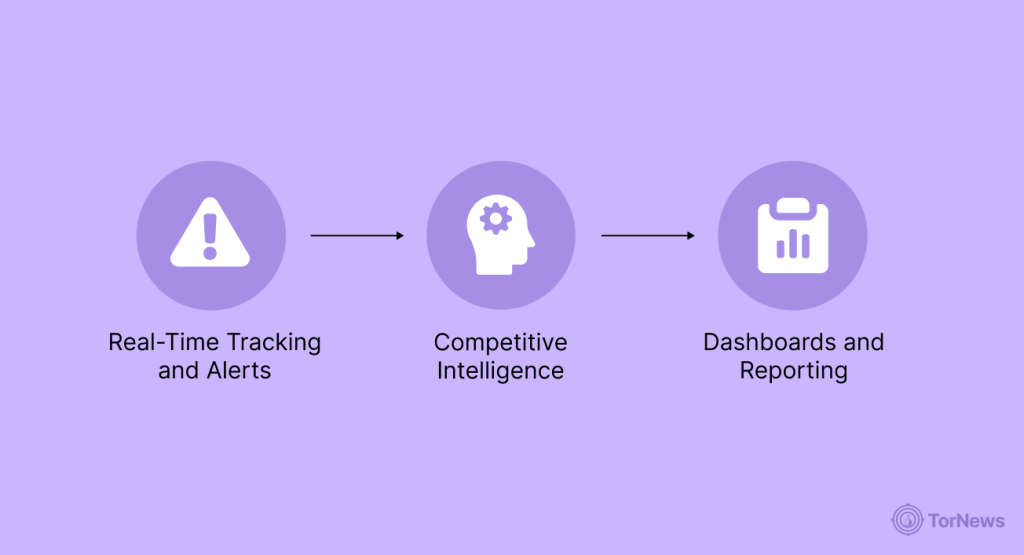
What makes up a social network monitoring tool? Track-ability, alert systems, data analysis; there’s a lot. But let’s look at the key features, a must-have for any monitoring tool for social media.
Real-Time Tracking and Alerts
The ability to monitor conversations as they happen is the foundation of effective social media monitoring. Real-time tracking provides instant notifications about brand mentions, keyword appearances, sentiment changes, or crisis indicators, so you can respond immediately when necessary.
Advanced alert systems let you customize based on urgency levels, sentiment scores, reach metrics, and source authority. This sophisticated alerting ensures your team gets timely notifications about critical issues while avoiding alert fatigue from less important mentions. (Because nobody wants their phone buzzing every five minutes about minor stuff!)
Sentiment Evaluation
A monitoring tool for social networks must not hover only around basic sentiment classifications. Thanks to evolution, we have machine learning and AI-built sentiment trackers that feed on human feedback. They look out for deeper emotions like excitement, pain point, confusion, as well as satisfaction.
They understand context, humor, and cultural variations. Simply put, these systems adapt to how language evolves. No wonder they dish out broad insights into customer satisfaction and brand perception. It’s like having a digital psychologist analyzing every conversation about your brand.
Competitive Intelligence
Remember, competitive monitoring is like a giraffe mode – long neck view. A social network monitoring tool should come with this capability to facilitate the analysis of competitor strategies, metrics, demographics, and buzzing sentiments.
You get to measure the percentage of your ‘share of voice’ over the competition and even figure out unique advantages from competitors’ loopholes. With these, your position in the marketplace becomes the spotlight. And well-thought planning? Top-notch. Call it a spy in your competitor’s marketing meetings (but totally legal!).
Customizable Dashboards and Reporting
A good monitoring tool must have user-friendly dashboards to keep things simple for both non-tech and tech-savvy stakeholders. That way, they can see through various metrics and insights without any challenges. Where there’s division of labor, a simple interface beats the task. The marketing team checks engagement and sentiments. The security guys are scanning suspicious patterns.
If your brand goes AI mode, automated reporting saves the day. No human sweat anymore! At the end of the day, you get summaries of every technical report necessary for your brand’s improvement. With how modern AI is going, you can switch between visuals and trend charts to get the whole gist.
Multi-Platform Integration
The best tools for monitoring social networks should collect data from as many sources as possible. Popular social platforms, blogs, news sites, forums, review platforms, emerging channels, the list can continue.
All in one place? Yes, that’s how you can maintain data quality. No filters yet. What about CRM platforms or marketing tools?
Well, if you want a holistic analysis, a social media monitoring tool that can connect to these platforms, is your best bet. It’s like having all your business tools talking to each other in perfect harmony.
Top Social Media Monitoring Tools
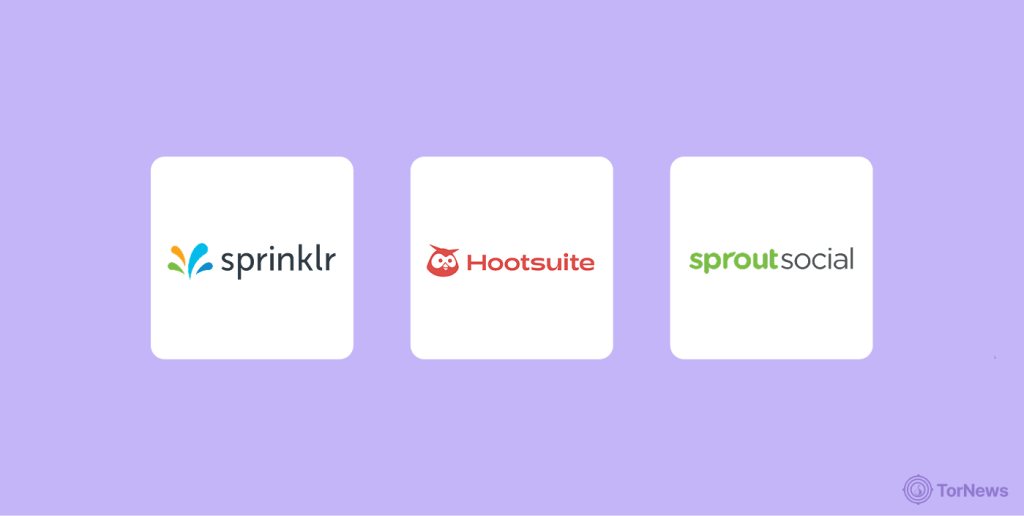
1. Sprinklr
Sprinklr is everyone’s dream tool just like the Ferrari. It’s the #1 for large enterprises doing an all-inclusive social media management plus monitoring. It can handle more than one social channel and even process bulky data streams all in one place. What’s more! You can manage consumer interactions from any part of the world.
Sprinklr “unifies” every insight no matter which platform it’s coming from and still maintains scalability in case you must perform enterprise-level operations. Thanks to its advanced AI, you can evaluate consumer behavior, sentiments, as well as competitions.
2. Hootsuite
As portable, reliable, and convenient, as a family car – that’s how you can think of Hootsuite. It doesn’t compromise value no matter the business size. So, for small or mid-sized ventures that want zero complexity or pricey plans, this is your best bet. Regardless, you can unlock enterprise-level features for scalable businesses but it comes with a higher cost.
Small, mid-size, and growing ventures can use its features to the fullest. You can even connect the tool with other marketing programs to get the most out of your monitoring journey. It allows you to track different keywords, hashtags, topics, and even competitors. You can label the data to show which team works on which data.
3. Sprout Social
Sprout Social is just right for small to mid-sized businesses because of its ease of use. Yet, it doesn’t compromise functionality. The platform puts social monitoring and management together, so you get an efficient workflow.
What about its UI design? You can perform your monitoring and management activities with or without tech experience. That’s how accessible the dashboard is for businesses. Still, you get in-depth insights to guide your decision.
You get all messages, mentions, and comments from different platforms all in one place. Say goodbye to switching between tabs. The platform notifies you about crises early with its alert systems. So, no negative sentiment spikes without your consent. You also get practical tips to manage them.
Latest Trends in Social Media Monitoring
Change is constant and here are some you can see within social monitoring practices:
Predictive Analytics With AI
Artificial intelligence makes the job easier. The systems can look into past patterns in conversations and sentiment. Then, it gives a hint at what to expect in the future from brand perception to crisis and opportunities. That way, you can take actions to prevent crises or harness opportunities.
The machine learning algorithms improve everyday so there’s accuracy in their predictions. Without a doubt, it all comes from new data, outcomes, and adaptation to the rollercoaster markets.
Next-Level Sentiment Analysis
We have AI tools like Meta and Grok in social media tools that catch sarcasm, cultural context, emojis, and even emotional states from texts.
Scary but true!
This sophistication enables more accurate brand perception measurement and better customer experience insights. No more wondering if that “great” comment was genuine or dripping with sarcasm! The integration of visual sentiment analysis adds another dimension, with AI systems capable of analyzing facial expressions in videos, image context, and visual brand sentiment indicators across multimedia content.
CRM and Social Media in One Place
Customer relationship management put together with social media is a unique approach making waves for brands. This unification allows you to merge social sentiment with purchase history, support interactions, and demographic data.
At the end, you get a broad understanding of your target market. Thanks to the integrated, you can auto-update customer profiles using the data at hand to send marketing campaigns perfect for each customer. You just gave your customer service team superpowers! Targeted marketing, next-level customer service, and lots more.
Real-Time Competitive Tracking
Competitive monitoring now collects data about competitors in real time. It processes the data and alerts you about competitors’ campaigns, product release, pricing modifications, and even customer reception patterns. There’s auto-benchmarking, share of voice assessment, and even threat evaluation from competitions.
With these, you curate strategic actions from a competitive standpoint. That’s an advantage in fast-moving markets. What’s more! You can learn from the challenges of competitors, their crisis management practices, and even strategic position.
It creates opportunities for brands that efficiently monitor their social networks. Sometimes their crisis can be your opportunity (though we’d never wish bad things on anyone!).
Visual Analysis
Visual analysis works thanks to Instagram, TikTok, YouTube, and many others. With image detection systems and AI, brands can know when someone else uses their licensed images or logo.
Whether it’s influencer partnerships or copyright infringement, the brand will know. They can know when you violate trademark or community guidelines of each platform. They also analyze the image to know where it best fits for marketing purposes.
How Social Media Monitoring Enhances Cybersecurity

One of the importance of social media monitoring is to catch threats early and fight them. Does it improve cybersecurity?
Without a doubt! How? Detect phishing schemes and block them. There’s more so let’s dive in
Catch and Flush Phishing Schemes
The bad guys online attack their victims through social media. That’s how they share those “http://ngfh.xyz/amazon/” phishing links, fake login pages, and impersonation. With social media monitoring, the cyber security experts can track suspicious links, fake profiles, and “weird” activity patterns.
You just accepted a friend request and boom you get a text from the same profile, “Thank you my fans, you won a great prize…”
Really? Don’t fall for such “weird” patterns. Once the good guys catch the source, they get rid of their schemes instantly to protect customers. In most cases, they send off alerts early to keep you on the same page.
Fish out Misleading News and Campaigns
“R1P Silvester Stallione” it’s blowing up on social media. Clearly, that’s false information spreading to basically farm engagements. Some false campaigns disrupt stock prices or ruin a brand’s image. Social media monitoring fishes out such schemes, profiles behind the campaign, and potential motives behind it. On request, they analysts can delete or report the campaign to stop it from further virality.
Block Brand Impersonation
“I’m Drake Woods, CEO of StarkLinks, support my brand with $50,000 and get $100,000”
That’s a typical approach the bad guys use with fake social profiles. They could come as MacDonalds, Starbucks, and the rest. Once they steal customer details, duping the customers comes next. Unknown to the brands, their reputations fall to the mud.
But with social media monitoring, cybersecurity responds even before any attack. Visual analysis will signal the appearance of your logo on another profile, similar username flags, and boom, you know what the bad guys are up to. In a blink, cybersecurity takes them down. It’s as active as a bouncer!
Disrupt Insider Threat
Employees get rebellious and may leak sensitive information, violate policy, or go as far as hacking the manager’s system. Well, with social network monitoring, you can find patterns that leak the identity of such employees.
How many times did Mr A visit Facebook, what did he post, what comments are there? That’s one clue you could get. While privacy is important, monitoring helps fish out suspicious accounts or content before any damages.
Once you understand employee sentiment and the workplace issues fueling it, adopt reconciliation. You could save the day without wearing a cape.
Monitor Data Breach
News flies faster through social media. So you can learn about data breaches online before traditional monitoring systems notice it.
Why?
Most times, the stolen information appears on various platforms. Also, discussion forums dwelling on data breach topics can give a head start too. Thus, social media monitoring can identify which customer data or credentials are on air. Monitoring systems can track mentions of organizational data, search for exposed email addresses or usernames, and identify discussions about potential security vulnerabilities.
This early warning capability enables rapid incident response and customer protection measures. Advanced monitoring includes dark web tracking capabilities, identifying when organizational data appears in underground markets or criminal forums accessible through social media channels. It’s like having eyes and ears in the digital underworld.
Social Media Monitoring Services and Their Benefits
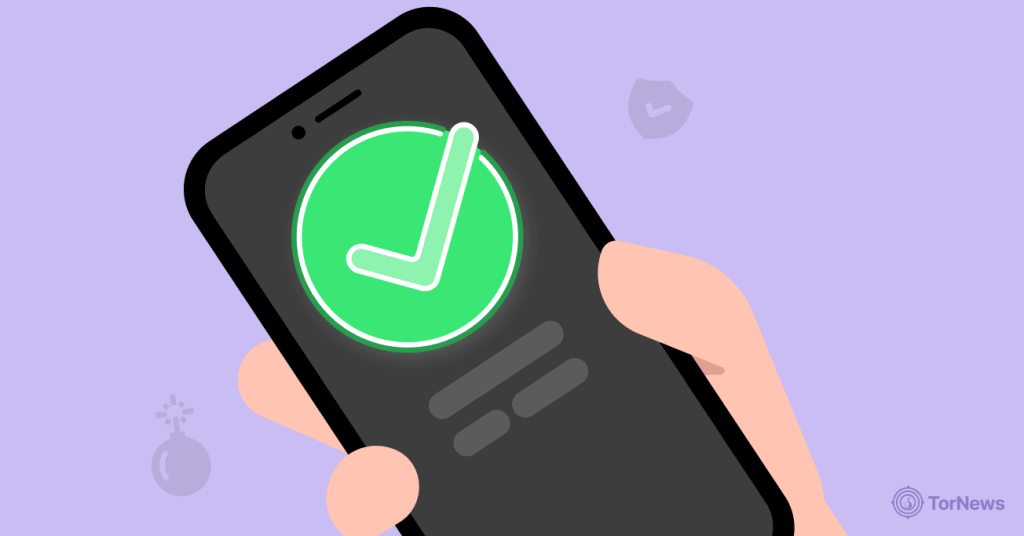
Professional social media monitoring services provide holistic solutions that encompass high-end tech, expert analysis, & strategic guidance. These services make sure that users enjoy top-notch monitoring that doesn’t require wasting too many internal resources or expertise.
Early Threat Detection and Response
Professional monitoring services make sure that users enjoy threat detention 24/7 and this is something that many organizations can’t achieve in house. These services only work with experts that understand how bad actors continue improving on their threat tactics and apart from that, can also easily recognize sophisticated attacks that many automated systems might not notice.
Expert analysts can easily know the difference between threats that are genuine and those that are simply false positives, and as such, can tackle attacks based on the level of risks they pose. By that, they can create the right strategy to respond faster and accurately. This expertise approach enables an organization not to overreact to simple issues or underplay the possible effect of serious threats.
It’s like having a team of digital security experts on call 24/7 on speed dial. Professional services also keep close working relationships with platform security teams, thereby ensuring that takedowns happen faster and threats are more preventable than when an organization handles everything internally.
Comprehensive Brand Protection
Brand protection services does more than simple mention tracking but goes farther to help the organization defend itself against reputation threats, activities of fraudsters and violations of intellectual properties. These services achieve this with a mix of monitoring technology, expertise in legal expertise matters and strength in enforcement.
Professional brand protection offers a lot of things which could be: monitoring an organization’s trademark, detecting counterfeit products, identifying retailers operating without authority, and managing a company’s reputation. This approach of encompassing multiple services helps a brand protect its integrity in all digital channels that matters.
Expert teams can also guide a brand on how to develop policies for protecting its systems, help them develop effective response protocols, and work with legal teams to enforce these things when the need arises.
Advanced Customer Intelligence and Insights
Professional monitoring services make use of experienced analysts capable of picking out strategic insights on social media data that you may not identify on your own. These experts know how industry trends moves, understand how competition works and how customer behavior changes without notice.
Advanced analysis covers everything from market segmentation following social behavior, mapping of customer journey using the way they interact on social platforms, and identifying probable customer needs or preferences. When these analysts gather this intelligence, they make use of them to support an organization’s strategic planning and business development.
Professional services can also help you to understand if your performance is up to par or not based on industry standards and competitors. If not, the analysts can help you identify the opportunities you can utilize to improve your performance.
Crisis Prevention and Management
Experienced monitoring services can notice when there are hints of imminent crises and come up with strategic guidance on how to respond to them. Professional crisis management achieves its goals by combining real-time monitoring with communication expertise.
The teams understand the effects which different response strategies can have on crisis evolution. The knowledge enables them to share the right approaches which an organization can use to reduce damages on its reputation and other unseen issues. This expertise is particularly valuable for organizations that do not have the experience it takes to communicate properly during a crisis.
Professional services also provide analysis after each crisis. This approach is to help you understand what happened, how effective your response was, and how to improve your level of preparedness for another crisis.
Regulatory Compliance and Documentation
Many industries require the documentation of customer communications and content monitoring to comply with regulatory requirements. Professional monitoring services assist in this with complete record-keeping while making sure the organization complies with relevant regulations.
These services are well-versed on compliance necessary in every industry and therefore customizes their monitoring approaches to meet regulatory needs. This expertise helps you avoid violations of regulations and penalties attached to such acts.
Another thing professional services offer to organizations is audit support, which helps you show regulators that you are obeying the laws and following the proper methods for documentation.
Choosing the Right Social Media Monitoring Platform
Before you choose any monitoring platform, first consider your organization; what are its needs, amount willing to invest in it, objectives that will move it forward and the technical requirements of such a platform. The right choice will depend on many factors that might not be the same for every organization. Let’s check them below:
Feature Requirements and Customization Options
You need to first decide on the monitoring needs your organization has. What are the real insights you need, how fast do you need to respond, and what systems must be put in place to make it all work. It might surprise you but different platforms don’t excel in the same areas therefore making it important that you pick features that aligns with your needs to achieve what you expect.
That said, you must look at features like the capability of the system to monitor social media platforms in real time. Secondly, its ability to analyze sentiments accurately, its competitive intelligence tools, the system in place for detecting threats and how effectively it reports all these.
You should also think about future needs and how fast your operation might scale so you don’t select a system that won’t accommodate the growth of your organization. Most importantly, make sure the monitoring hub allows you the power to customize it especially if your organization has special security needs, specific industry requirements, and different workflows.
The best platforms to choose are those that allow you to easily configure so it can easily adapt to your organization’s requirements when it changes.
User Interface and Ease of Use
If a platform is easy to use, it means your team will actually use it and this will determine how efficiently they’ll work with it. So try to check the UI (user interfaces) from the standpoint of different users which could be executives who need high-level dashboards, analysts who can only work with seamless data access, and response teams who need the ability to respond very swiftly to queries and complaints.
Don’t also forget that training requirements & learning curves are not the same on different platforms. So, don’t forget to consider the level of technical skill your team has and the possible time you can allow them to train on any particular platform without interrupting your usual operations. This is important when checking how a platform’s UI is- user-friendly or feature-rich but too technical.
One other aspect of easy-to-use platforms is how accessible they are on mobile devices. This is important because teams might need to monitor things on the go or to work outside the office. Looking at that, your choice of a platform must allow the teams to use all its features through a mobile app or web interface which they can access without glitches.
Integration Capabilities & Compatibility
Modern monitoring platforms must be such that you can easily combine with the business system you have on ground and this includes your CRM platforms, security information systems, tools for marketing automation and even your customer service systems. The integration capabilities of any platform you choose will tell you if the monitoring data it generates will be beneficial to your larger business work processes.
API availability and quality will always affect your current integrations & the possibility of a future expansion so, it becomes necessary to evaluate API, rate limits, and data export capabilities to be sure that the platform can be flexible and not entrap you forever. You don’t want to remain with one vendor for the entire business life circle.
Another important thing is the consideration between cloud versus on-premise deployment options that affect how complex integration becomes, the security requirements, and recurring needs for maintenance. Check your IT infrastructure and security policies when trying to consider deployment options.
Pricing Models and Budget Considerations
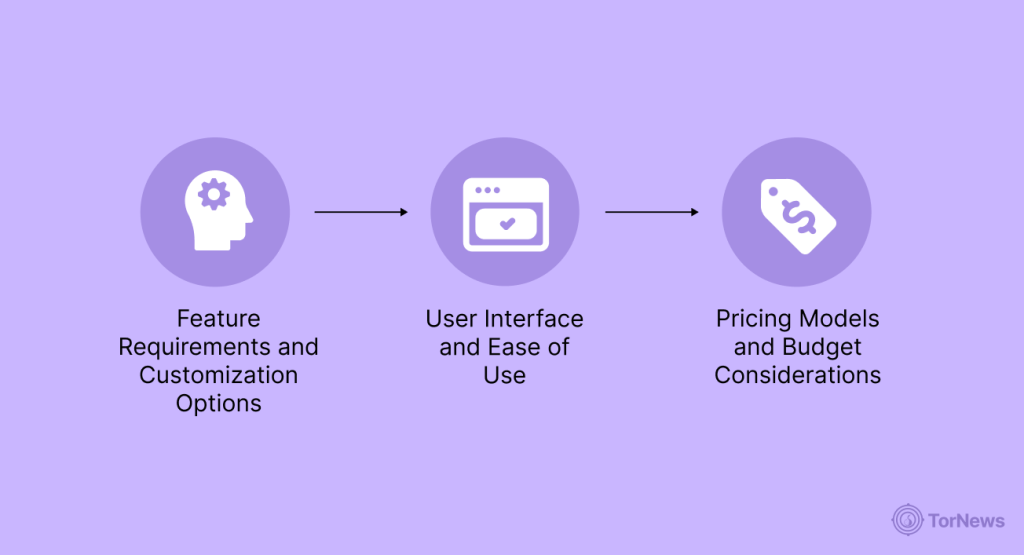
The monitoring platform comes with different prices and this is because their user count, features, volume of data, and levels of service are not the same.
So before going on with any of them, check the price package to know everything you have to pay that might cover training costs, setting up fees, and other support expenses they might later demand from you. Don’t ever only rely on the sticker price, you might be shocked later.
Very importantly, scalability pricing is particularly important for organizations that are still growing. Some platforms design their pricing to scale with the level of usage while some others set their up too rigidly with tier upgrades negatively affecting organizations that are not growing fastly.
Customer Support and Service Quality
The quality of the technical support a platform offers goes a long way to determine how effective a monitoring exercise can be especially when there is a crisis that needs swift attention or response. So, check how available the support is, how long it takes them to respond and how effective they are in solving issues or responding to crises.
Another thing is the training and onboarding services the platform offers as this could determine how successful the implementation is and the value the organization derives based on time used.
The best vendors to consider are those that offer a training program that will teach your team everything they need to know in a short time, provide them with resources for documentation and stand by to support them with more information when necessary to make sure they achieve the goals of using the platform.
What about account management & strategic consultation services? These are also very crucial because they help ensure you get more value from service that goes beyond technical support.
Conclusion
Social media monitoring is not just a “marketing” practice. It’s a discipline that allows brands to uphold their reputation, learn about their customers, get an edge in the cybersecurity space, and even curate strategic plans.
As such, brands that understand and adopt the discipline take the center stage amidst their competition. Just have the right tools, be proactive when you listen, and reactive when you monitor. You’ll get efficient insights and even a competitive edge to top it off.
As long as people use social media, this practice will always remain relevant in this digital world. Thanks to evolution, we now have AI, visual analysis, and predictions, which makes it even more extraordinary.
If you joined the train now, you’d be geared up for what the future has in stock: challenges, opportunities, and lots more. The question isn’t whether your organization needs social media monitoring – it’s how quickly you can harness this prospect to protect and level up your digital interests. This guide already gives you a headstart with trends, techniques, and the right tools. Yet, you must adapt, learn, and apply what works over time.
FAQs
It basically means to keep an eye on certain gists, topics, keywords, and tags on a social platform. The information you collect can then serve as a guide to learn about trends, pressing needs, and opportunities early.
Brands use these tools to know who mentions them or use certain keywords that point to them. They also use them to learn about their competitors and customers. These tools serve as detectives to fish out fake profiles and cyber threats against brands. Moreover, they help brands devise promotion campaigns that win and put their image in the limelight.
With this practice, a restaurant can track consumer reviews and tags. They can also respond to inquiries quickly. Another example is a tech firm looking out for discussions on social media about “product launch” to get an edge ahead of its rivals.
Businesses need it to know what their customers are saying, how they’re reacting, and what they could be expecting. Otherwise, they could face reputation crises due to poor relationships with its customers. Moreover, social media monitoring keeps business up-to-the-minute. That’s how they find hot products and capitalize on them.
Yes, and you can find a lot of them on the internet. The only challenge is that they have limits to what they can do; unlike paid tools. Some free options worth trying are Google Alerts, Hootsuite, Meta Business Suite, and TweekDeck. Want to get the most, go for premium tools. They have advanced capabilities for any business size.
The good side: it provides insights in real time which can help a brand level up their customer service, online security, and build a marketing plan that works. However, the down side is that the millions of data could cause analysis paralysis. Also, the cost of running the tools at the enterprise level can be pricey.
One of the pain points is that organizations will need a skilled analyst that can translate the data accurately and curate practical next steps. With AI stepping in, these could be less of a challenge!
Through SaaS apps like Sprinklr, or Hootsuite. The list can continue. Another way is to adopt “managed service providers.” They do the job and still provide expert support on demand.
The most important contents that must appear in a PDF guide for social media monitoring are the step-by-step workflows, how to handle crises, metrics and KPI tracking. In fact, such PDFs should provide all you need to know to monitor social media properly.
